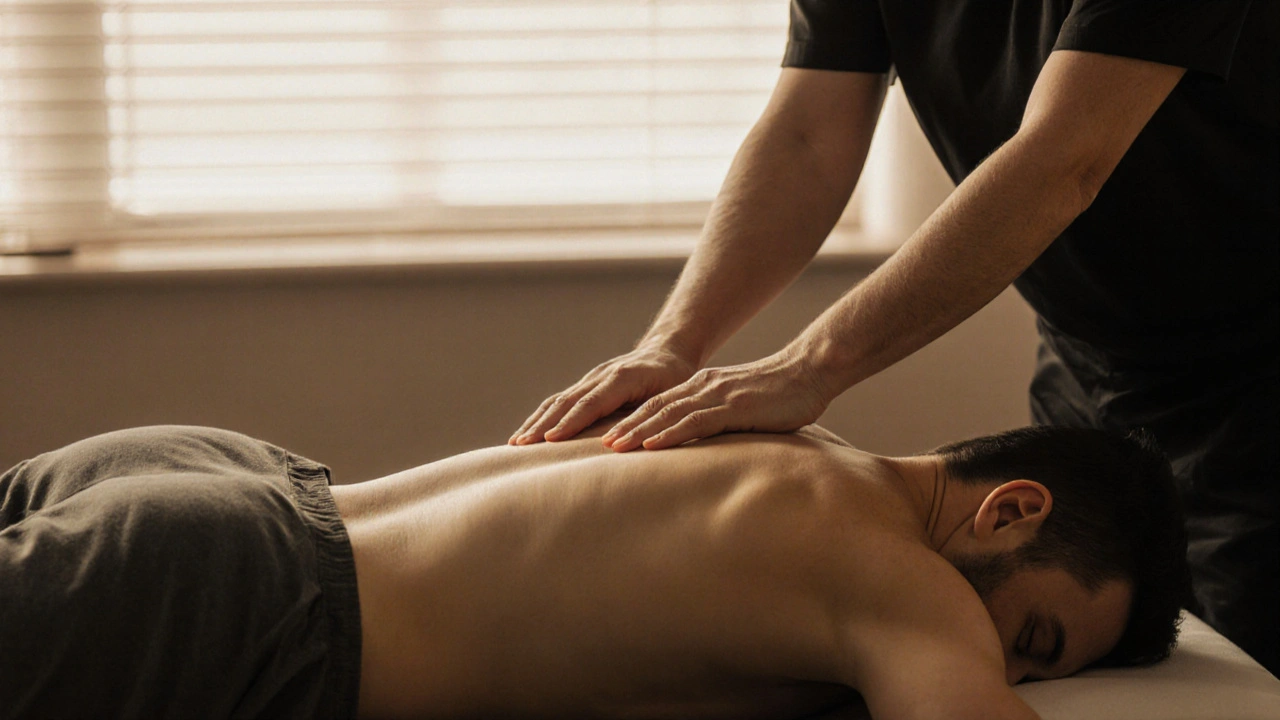Myofascial Release Therapy: How It Relieves Chronic Pain and Why It’s Gaining Traction

Myofascial Release Benefit Assessment
How Myofascial Release May Help You
Based on research, myofascial release therapy targets the connective tissue surrounding your muscles. It may be beneficial if your chronic pain:
- Shifts locations (e.g., from back to thigh or shoulder)
- Has no clear cause on imaging tests
- Worsens after sitting or repetitive motions
- Feels like deep, persistent tension rather than sharp pain
- Has improved with DIY techniques but not permanently
For years, people with chronic pain have been told to take pills, get injections, or wait it out. But what if the real problem isn’t your spine, your joints, or your muscles - it’s your fascia? That’s the quiet, overlooked tissue wrapping every muscle, bone, and organ in your body. When it gets tight, sticky, or scarred, it pulls on everything around it. That’s where myofascial release therapy comes in - and it’s not just another spa trend. People in Melbourne, Sydney, and even rural clinics are reporting real relief after years of failed treatments.
What Exactly Is Myofascial Release Therapy?
Myofascial release therapy, or MFR, is a hands-on technique that targets the fascia - the thin, web-like connective tissue that holds your body together. Think of it like shrink-wrap around your muscles. When you get injured, stressed, or sit too long, this wrap tightens up. It doesn’t show up on X-rays or MRIs, but it can cause pain that feels like it’s coming from your hip, neck, or back - even when those areas are fine.
Unlike traditional massage that pushes on muscles, MFR uses slow, sustained pressure - often holding for 90 seconds to five minutes - to let the fascia soften and release. It’s not about popping or cracking. It’s about patience. A 2023 study in the Journal of Bodywork and Movement Therapies found that patients with chronic low back pain who received weekly MFR sessions for eight weeks saw a 47% reduction in pain intensity, compared to just 12% in the control group.
Why It Works When Other Treatments Don’t
Most pain treatments focus on symptoms. Painkillers dull the signal. Physical therapy strengthens muscles. Chiropractic adjustments move bones. But if the fascia is stuck, none of those fix the root cause.
Imagine your fascia like a tangled headphone cord. You can pull on the earbuds all day, but unless you untangle the knot, it won’t work right. MFR is like gently working that knot loose with your fingers. It doesn’t force anything. It waits. And when the fascia finally lets go, pain often drops - sometimes dramatically.
People with fibromyalgia, plantar fasciitis, migraines, and even post-surgical scarring are finding relief. One woman in Ballarat, who’d had constant headaches for seven years after a car accident, tried everything: neurologists, acupuncture, steroids. Nothing worked. After six MFR sessions focused on her neck and jaw fascia, her headaches dropped from daily to once a month.
How It’s Done - And What to Expect
A typical MFR session lasts 60 to 90 minutes. You lie on a table, fully clothed in loose, comfortable clothes. The therapist uses their hands, knuckles, or elbows to apply gentle, steady pressure to tight areas. There’s no cracking. No deep tissue pounding. It’s slow. Sometimes it feels like a deep warmth spreading. Other times, it’s uncomfortable - but not sharp or burning.
Most people feel immediate relief after the first session. But because fascia takes time to reorganize, therapists usually recommend a series of 4 to 8 sessions over 4 to 6 weeks. After that, maintenance sessions every 4 to 8 weeks help keep things loose.
It’s not for everyone. If you have severe osteoporosis, open wounds, or blood clots, MFR isn’t safe. But for most people with long-term, unexplained pain, it’s low-risk and high-reward.
Where It Fits in Modern Pain Care
Doctors are starting to notice. In Australia, physiotherapists trained in MFR are now being referred by GPs for chronic pain cases that don’t respond to standard care. Hospitals in Brisbane and Adelaide have added MFR to their pain management programs. It’s not replacing surgery or medication - it’s filling the gap between them.
Unlike drugs, it has no side effects. Unlike surgery, it’s non-invasive. And unlike generic massage, it targets the specific tissue causing the problem. That’s why it’s gaining traction - not because it’s trendy, but because it works where other things fail.

DIY Myofascial Release: Can You Do It at Home?
You don’t need a therapist to start. Foam rollers, tennis balls, and even massage balls designed for fascia can help. Roll slowly over tight spots - like your calves, upper back, or hips - and pause for 30 to 60 seconds when you find a tender area. Breathe. Don’t push through pain. Let the tissue soften.
But here’s the catch: DIY MFR works best for general tightness. If your pain is deep, persistent, or radiating, you’re likely dealing with fascial adhesions that need a trained eye. A therapist can feel the difference between muscle tension and true fascial restriction. They know where to press, how long to hold, and when to stop.
Think of it like brushing your teeth vs. seeing a dentist. You can do the basics yourself - but some problems need professional help.
Who Benefits Most?
Not everyone needs MFR. But these groups see the biggest results:
- People with chronic pain that moves around - like pain that shifts from the lower back to the thigh or shoulder
- Those with fibromyalgia or chronic fatigue syndrome
- Recovery from surgery or injury where scar tissue formed
- Runners, cyclists, or desk workers with tight hips, shoulders, or necks
- People who’ve tried physical therapy but still feel stiff or restricted
If your pain has been labeled "idiopathic" - meaning no clear cause - MFR is worth exploring. Many of these cases turn out to be fascial restrictions masquerading as something else.
The Science Behind the Sensation
It’s not magic. Fascia is packed with sensory nerves - more than muscle tissue. When it’s stuck, those nerves fire constantly, sending pain signals to your brain. MFR helps reset them. Studies using ultrasound imaging show that after MFR, the fascia becomes more fluid and less dense. It literally unglues.
Another mechanism? The vagus nerve. Slow, sustained pressure activates this nerve, which calms your nervous system. That’s why people often feel deeply relaxed - even sleepy - after a session. It’s not just pain relief. It’s nervous system recalibration.

Cost, Accessibility, and Finding a Qualified Therapist
In Australia, a single MFR session costs between $80 and $150, depending on location and therapist experience. Many private health funds cover it under "remedial massage" or "physiotherapy" extras. Check your policy.
To find a qualified therapist, look for someone with certification from the Myofascial Release Treatment Centers or John F. Barnes Myofascial Release Approach. Avoid therapists who promise instant results or use lots of force. True MFR is quiet, slow, and patient.
It’s not widely available in every town yet - but it’s growing fast. In Melbourne, you can find certified MFR practitioners in CBD clinics, physio practices, and even some yoga studios.
What It Doesn’t Do
MFR isn’t a cure-all. It won’t fix a herniated disc. It won’t reverse arthritis. It won’t replace exercise or nutrition. But it can remove the hidden tension that makes those conditions feel worse.
Think of it like removing a rock from your shoe. The shoe is still old, and your foot might still ache - but now you can walk without limping.
That’s the power of MFR. It doesn’t fix your body. It just lets it move the way it was meant to.
Is myofascial release therapy the same as massage?
No. Traditional massage focuses on relaxing muscles using rhythmic strokes and kneading. Myofascial release targets the fascia - the connective tissue - with slow, sustained pressure. It’s not about loosening muscles; it’s about releasing restrictions in the tissue that pulls on muscles, bones, and nerves. The technique is quieter, slower, and often more uncomfortable in a deep, dull way - not the sore-but-good feeling of a massage.
How many sessions do I need to see results?
Most people feel some relief after the first session, but lasting change takes time. Fascia reorganizes slowly. A typical treatment plan is 4 to 8 sessions over 4 to 6 weeks. After that, monthly or bi-monthly maintenance sessions help prevent tightness from coming back. Chronic conditions like fibromyalgia or post-surgical pain may require longer-term care.
Does myofascial release therapy hurt?
It shouldn’t hurt in a sharp or burning way. You might feel a deep ache, warmth, or pressure - sometimes intense - but it should never feel like pain that makes you tense up. If it does, tell your therapist. True MFR works by allowing the tissue to release naturally, not by forcing it. The best sessions feel like a slow melting, not a punch.
Can I do myofascial release at home?
Yes, but with limits. Foam rollers, tennis balls, or massage balls can help with general tightness in areas like your calves, back, or hips. Roll slowly and pause on tender spots for 30 to 60 seconds. But if your pain is deep, radiating, or has lasted years, DIY methods won’t reach the root. A trained therapist can detect fascial restrictions you can’t feel and apply the right pressure for the right duration.
Is myofascial release therapy covered by insurance?
In Australia, many private health funds cover MFR under their remedial massage or physiotherapy extras. Coverage depends on your policy and whether the therapist is a registered provider. Always check with your insurer before booking. Some clinics also offer bundled packages or sliding-scale fees for ongoing care.
Who shouldn’t try myofascial release therapy?
People with severe osteoporosis, open wounds, recent fractures, blood clots, or active cancer should avoid MFR. Those on blood thinners should consult their doctor first. If you’re pregnant, work with a therapist trained in prenatal MFR. Always disclose your full medical history - even if you think it’s irrelevant.
What Comes Next?
If you’ve tried everything and still feel tight, stiff, or in pain - it’s time to look beyond the obvious. Myofascial release therapy isn’t a miracle. But for the millions of people whose pain has no clear cause, it’s the missing piece. It’s not about fixing your body. It’s about letting it move again.
Start with one session. See how your body responds. You might be surprised at how much tension you’ve been carrying - and how easily it can let go.





